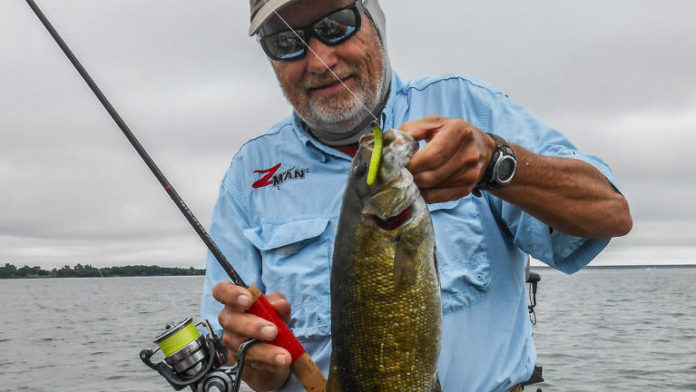Short spinning rods have played a vital role in the development of Midwest finesse bass fishing from the get-go.
Much of the genesis of this great piscatorial method and tools began at Ray Fincke’s tackle shop on Southwest Boulevard in the Rosedale neighborhood of Kansas City, Kansas, in the 1960s.
At the age of 16, Ray inherited the shop when his father, Louis, unexpectedly died in 1952. The tackle shop began in the 1930s in the office of his father’s hardware store, and it catered primarily to fly fishermen.
In 1960, a serendipitous event occurred that has a magnificent effect on the angling world for the next 61 years, and it is likely to continue for many more years.
It began when Ray Fincke built and moved into a house next door to Drew Reese’s family. What’s more, Drew’s father was the proprietor of an automobile dealership on Southwest Boulevard near Ray’s tackle shop, and Ray’s wife worked for Drew’s father at the automobile dealership. At that time, Drew was 13 years old and joyously afflicted with fishing fever, and his father encouraged him to talk to Ray about fishing. After that initial conversation, Ray and Drew became devoted friends, and at the age of 13, Drew began tying flies for the tackle shop. Throughout his high-school years and until he graduated from the University of Kansas in 1969, Drew worked part-time at Fincke’s shop.
From Ray, Drew learned a lot about the art and some of the science of making fishing rods – especially spinning rods. This, of course, occurred many years before spinning rods began to play a significant role in the repertoire of the vast majority of black-bass anglers in the United States and Canada.
Drew’s first fishing trip with Ray occurred in 1961. Ray took Drew and his father to fish for rainbow trout at Lake Tanyecomo’s tailrace below Table Rock Lake’s dam. Ray provided them with two very inexpensive buggy-whip spinning rods and Compac spinning reels that were spooled with four-pound-test monofilament line. To each of the lines, Ray affixed a split shot and a wooly-worm fly that Drew had created. To their delight and amazement, Drew and his father caught more than 100 trout, and Drew’s lifetime passion for finesse fishing was lit. Then 10 years later, he used his Midwest finesse tactics to compete at the first BASS Master Classic at Lake Mead, Nevada, where he finished in seventh place, using six-pound-test line.
As the 1960s unfolded, the clientele at Ray’s tackle shop expanded, and it became a gathering spot for all sorts of anglers. On Monday nights, it was a quasi-bass club before the advent of bass clubs and organizations like Bass Anglers Sportsman Society. It was where the great and late Chuck Woods, who created the Beetle, Beetle Spin, and Puddle Jumper, would often be fiddling with lures and try to create new ones. And Ray began creating an array of rods and selling tackle for the black-bass anglers to use.
Besides Drew Reese, all of those goings-on at Ray’s shop in the 1960s also caught the attention of another high school and college student. It was Dwight Keefer, who eventually used one of Fincke’s rods and some of Woods’ lures to win the World Series of Sport Fishing at Long Lake, Wisconsin, in 1967. Keefer also competed in the BASS Master Classic at Percy Priest Reservoir, Tennessee, in 1972.
From the 1950s until his death on Mar. 21, 2011, Ray Fincke built and repaired scores of casting, fly, and spinning rods for area anglers. He was regularly lauded for his genius at rebuilding or restoring bamboo fly rods. His most renowned creation was a 5-foot, 4-inch finesse spinning rod that he called the Stinger. It was made from two blanks. One was a fiberglass blank that was 19 inches long. The other one was an ultra-light graphite blank that was four-feet, six inches long. To lengthen the rod and add more power to the butt section, Fincke slid the 19-inch piece of the fiberglass blank over the graphite blank and firmly glued the blanks together, and then he used wrapping thread to decoratively cover the union of the two blanks. The butt of the rod was fitted with a nine-inch cork handle. This rod sported five stainless steel guides: a No. 25, No. 16, No. 12, and No. 10. The tip was a No. 8 Carboloy.
Ultimately, Fincke’s influence on finesse fishing expanded across the entire nation when he helped Gary Loomis design the 5-foot, 4-inch and 5-foot, 10-inch Classic Spin Jig rods in 1981 and 1982. In essence, these two rods were similar to Fincke’s Stinger. They became the G. Loomis SJ 6400 and SJ 700 rods, which were described as possessing an extra-fast action with a magnum-light rod power. They were ideal rods for wielding small marabou or hair jigs, Beetles, Beetle Spins, and jig-worms.
Drew Reese became wedded to the SJ 6400 and SJ 700 in 1982, and across those many years of using those rods, he became one of the world’s finest practitioner of Midwest finesse fishing, which he prefers to call light-line fishing.
Nowadays, Reese, who is 74 years old, lives in rural northeastern Kansas near the town of Rantoul. And except during the Covid-19 pandemic and lockdown, he has spent a lot of his days chasing smallmouth bass that abide in the Lake of the Woods in Ontario, Canada, Lake Erie, and Bull Shoals Lake in Arkansas. Since 2011, he has played a role in persuading Z-Man Fishing Products to manufacture a jighead and several soft-plastic baits for Midwest finesse applications.
After Gary Loomis sold his company to Shimano in 1995, the availability of the SJ 6400 and SJ 700 rod blanks gradually came to an end. But it wasn’t until the spring of 2021 that Drew began searching the Internet in hopes of finding similar rod blanks. But because the modern-day angling world is enamored (for some unenlightened or benighted reason) with long rods, it was a chore to find a blank that was less than 6 feet long.
Credit: Source link































